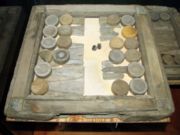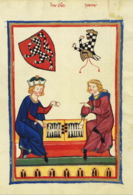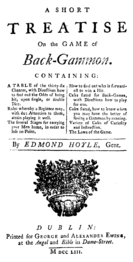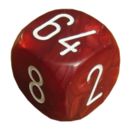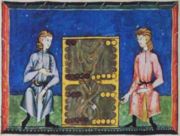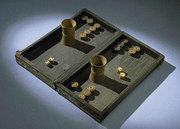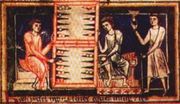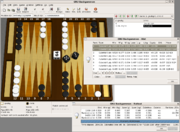Backgammon
2008/9 Schools Wikipedia Selection. Related subjects: Games
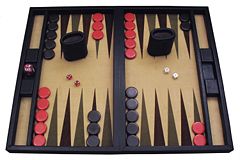 A backgammon set, consisting of a board, two sets of 15 checkers, two pairs of dice, a doubling cube, and dice cups |
|
| Players | 2 |
|---|---|
| Age range | 5+ |
| Setup time | 10–30 seconds |
| Playing time | 5–30 minutes |
| Random chance | Dice |
| Skills required | Counting, Tactics, Strategy, Probability |
Backgammon is a board game for two players in which the playing pieces are moved according to the roll of dice. A player wins by removing all of his checkers from the board. There are many variants of backgammon, most of which share common traits. Backgammon is a member of the tables family, one of the oldest classes of board games in the world.
Although luck plays an important role, there is a large scope for strategy. With each roll of the dice a player must choose from numerous options for moving his checkers and anticipate possible counter-moves by the opponent. Players may raise the stakes during the game. There is an established repertory of common tactics and occurrences.
Like chess, backgammon has been studied with great interest by computer scientists. Owing to this research, backgammon software has been developed capable of beating world-class human players.
History
The ancient Egyptian game senet resembled backgammon, with moves controlled by the roll of dice. However, the Royal Game of Ur, played in ancient Mesopotamia, is a more likely ancestor of modern day tables games. Excavations at the " Burnt City" in Iran have shown that a similar game existed there around 3000 BC. The artifacts include two dice and 60 checkers, and the set is believed to be 100 to 200 years older than the sets found in Ur.
The ancient Romans played a number of games remarkably similar to backgammon. Ludus duodecim scriptorum ("Game of twelve lines") used a board with three rows of 12 points each, and the checkers were moved across all three rows according to the roll of dice. Little specific text about the gameplay has survived. Tabula, meaning "table" or "board", was a game mentioned in an epigram of Byzantine Emperor Zeno (AD 476–481). It was similar to modern backgammon in that the object of the game was to be the first to bear off all of one's checkers. Players threw three dice and moved their checkers in opposing directions on a board of 24 points.
In the 11th century Shahnameh, the Persian poet Ferdowsi credits Burzoe with the invention of the tables game nard in the 6th century. He describes an encounter between Burzoe and a Raja visiting from India. The Raja introduces the game of chess, and Burzoe demonstrates nard, played with dice made from ivory and teak. (Today, Nard is the name for the Persian version of backgammon, which has different initial positions and objectives.)
The jeux de tables (Game of Tables), predecessors of modern backgammon, first appeared in France during the 11th century and became a favorite pastime of gamblers. In 1254, Louis IX issued a decree prohibiting his court officials and subjects from playing. Tables games were played in Germany in the 12th century, and had reached Iceland by the 13th century. The Alfonso X manuscript Libro de los juegos, completed in 1283, describes rules for a number of dice and tables games in addition to its extensive discussion of chess. By the 17th century, tables games had spread to Sweden. A wooden board and checkers were recovered from the wreck of the Vasa among the belongings of the ship's officers. Backgammon appears widely in paintings of this period, mainly those of Dutch and German painters (Van Ostade, Jan Steen, Bosch and others). One surviving artwork is " Cardsharps" by Caravaggio (The backgammon board is in the lower left.) Others are the Hell of Bosch and interior of an Inn by Jan Steen.
In the 16th century, Elizabethan laws and church regulations prohibited playing tables, but by the 18th century backgammon was popular among the English clergy. Edmund Hoyle published A Short Treatise on the Game of Back-Gammon in 1743; this described rules and strategy for the game and was bound together with a similar text on whist.
In English, the word "backgammon" is most likely derived from "back" and Middle English "gamen", meaning "game" or "play". The earliest use documented by the Oxford English Dictionary was in 1650.
The most recent major development in backgammon was the addition of the doubling cube. It was first introduced in the 1920s in New York City among members of gaming clubs in the Lower East Side. The cube required players not only to select the best move in a given position, but also to estimate the probability of winning from that position, transforming backgammon into the expected value-driven game played in the 20th and 21st centuries.
Rules
The objective is to move all of one's own checkers past those of one's opponent and then remove them from the board. The checkers are scattered at first and may be blocked or hit by the opponent. As the playing time for each individual game is short, it is often played in matches, where victory is awarded to the first player to reach a certain number of points.
Setup
Each side of the board has a track of 12 long triangles, called points. The points are considered to be connected across one edge of the board, forming a continuous track in the shape of a horseshoe, and are numbered from 1 to 24. Each player begins with two checkers on his 24-point, three checkers on his 8-point, and five checkers each on his 13-point and his 6-point. The two players move their checkers in opposing directions, each from his own 24-point towards his 1-point.
Points 1 through 6 are called the home board or inner board, and points 7 through 12 are called the outer board. The 7-point is referred to as the bar point, and the 13-point as the mid point.
Movement
To start the game, each player rolls one die, and the player with the higher number moves first using both the numbers shown. Both dice must land completely flat on the right hand side of the gameboard. The players then alternate turns, rolling two dice at the beginning of each turn.
After rolling the dice a player must, if possible, move his checkers according to the number of pips shown on each die. For example, if the player rolls a 6 and a 3 (noted as "6-3"), that player must move one checker six points forward, and another checker three points forward. The same checker may be moved twice as long as the two moves are distinct: six and then three, or three and then six, but not all nine at once. If a player rolls two of the same number, called doubles, that player must play each die twice. For example, upon rolling a 5-5 that player must move four checkers forward five spaces each. It can sometimes happen that a player can not play his entire roll, in which case as much of the roll as possible must be used. For example if a player rolls 6-3 and can only move a 6 or a 3, the 6 being the bigger number must be moved; if it is possible to move the 3 but not the 6 then the 3 is played.
In the course of a move, a checker may land on any point that is unoccupied or is occupied only by a player's own checkers. It may also land on a point occupied by exactly one opposing checker; such a lone piece is called a blot. In this case, the blot has been hit, and is placed in the middle of the board on the bar that divides the two sides of the playing surface. A checker may never land on a point occupied by two or more opposing checkers; thus, no point is ever occupied by checkers from both players simultaneously.
Checkers placed on the bar re-enter the game through the opponent's home board. A roll of 2 allows the checker to enter on the 23-point, a roll of 3 on the 22-point, and so forth. A player may not move any other checkers until all checkers on the bar belonging to that player have re-entered the game.
When all of a player's checkers are in that player's home board, that player may start removing them; this is called bearing off. A roll of 1 may be used to bear off a checker from the 1-point, a 2 from the 2-point, and so on. A die may not be used to bear off checkers from a lower-numbered point unless there are no checkers on any higher points. For example if a player rolls a 6 and a 5, but has no checkers on the 6-point, though 2 checkers remain on the 5-point, then the 6 and the 5 must be used to bear off the 2 checkers from the 5-point. When bearing off, a player may also move a lower die roll before the higher even if that means 'the full value of the higher die' is not fully utilized. For example, if a player has exactly 1 checker remaining on the 6-point, and rolls a 6 and a 1, the player may move the 6-point checker 1 place to the 5-point with the lower die roll of 1, and then bear that piece off the 5-point using the die roll of 6; this is sometimes useful tactically.
If one player has not borne off any checkers by the time that player's opponent has borne off all fifteen, then the player has lost a gammon, which counts for double a normal loss. If the losing player has not borne off any checkers and still has checkers on the bar or in the opponent's home board, then the player has lost a backgammon, which counts for triple a normal loss.
Doubling cube
To speed up match play and to provide an added dimension for strategy, a doubling cube is normally used. The doubling cube is a six-sided die marked with the numbers 2, 4, 8, 16, 32, and 64. At the start of each game, the doubling cube is placed in the middle of the board with the number 64 showing; the cube is then said to be "centred on 1". When the cube is centred, and before rolling the dice on his turn, either player may propose that the game be played for twice the current stakes. His opponent must either accept ("take") the doubled stakes or resign ("drop") the game immediately. If the opponent takes, the cube, showing the doubled stake, is moved to his side of the board. Thereafter, the right to redouble belongs exclusively to the player who last accepted a double. Whenever a player accepts doubled stakes, the cube is placed with the corresponding power of two facing upward.
The game is rarely redoubled beyond four times the original stake, but there is no limit on the number of doubles. Although 64 is the highest number depicted on the doubling cube, the stakes may rise to 128, 256, and so on. In money games, a player is often permitted to "beaver" when offered the cube, doubling the value of the game again, while retaining possession of the cube.
Some money games use the "automatic double" rule. If both opponents roll the same opening number, the doubling cube is incremented on each occasion yet remains in the middle of the board, available to either player. When a player decides to double his opponent, the value is then a double of whatever face value is shown (e.g. if two automatic doubles have occurred putting the cube up to 4, the first in-game double will be for 8 points).
A variant of the doubling cube "beaver" is the "raccoon." The player who doubled his opponent, seeing him beaver the cube, may in turn then double the stakes once again ("raccoon") as part of that cube phase before any dice are rolled. His opponent retains the doubling cube. E.g. White doubles Black to 2 points, Black accepts then beavers the cube to 4 points; White, confident of a win, raccoons the cube to 8 points, whilst Black retains the cube. Such a move adds greatly to the risk of having to face the doubling cube coming back at 8 times its original value when first doubling the opponent (offered at 2 points, counter offered at 16 points) should the luck of the dice change.
The Jacoby rule allows gammons and backgammons to count for their respective double and triple values only if the cube has already been offered and accepted. This encourages a player with a large lead to double, possibly ending the game, rather than to play it to conclusion hoping for a gammon or backgammon. The Jacoby rule is widely used in money play but is not used in match play.
The Crawford rule is designed to make match play more equitable for the player in the lead. If a player is one point away from winning a match, that player's opponent will always want to double as early as possible in order to catch up. Whether the game is worth one point or two, the trailing player must win to continue the match. To balance the situation, the Crawford rule requires that when a player first reaches a score one point short of winning, neither player may use the doubling cube for the following game, called the Crawford game. After the Crawford game, normal use of the doubling cube resumes. The Crawford rule is used in tournament match play.
If the Crawford rule is in effect, then another option is the Holland rule, which stipulates that after the Crawford game, a player cannot double until after at least two rolls have been played by each side. It was common in tournament play in the 1980s but is now rarely used.
Variants
There are many variants of standard backgammon rules. Some are played primarily throughout one geographic region, and others add new tactical elements to the game. Variants commonly alter the starting position, restrict certain moves, or assign special value to certain dice rolls, but in some geographic regions even the direction of the pieces and rules change, rendering the game fundamentally different.
A common simple variant of Backgammon is to only allow a maximum of five checkers on any point. This variation is not part of the official rules, but has proved popular with casual players in some regions. The popular GNU Backgammon software has an option for this, which is described as the 'Egyptian Rule', however the origin of that name might be due to a humorous invention.
Acey-deucey is a variant of backgammon in which players start with no checkers on the board, and must bear them on at the beginning of the game. The roll of 1-2 is given special consideration, allowing the player, after moving the 1 and the 2, to select any doubles move of his choice. A player also receives an extra turn after a roll of 1-2 or of doubles.
Hypergammon is a variant of backgammon in which players have only three checkers on the board, starting with one each on the 24-, 23- and 22-points. The game has been strongly solved, meaning that exact equities are available for all 32 million possible positions.
Nackgammon is a variant of backgammon invented by Nack Ballard in which players start with one fewer checker on the six point and midpoint and two checkers on the 23 point.
Prison is a variant of backgammon in which players start with all 15 checkers on the 24 point and when a solo checker gets hit, instead of being taken off the board, the opponent's checker remains on top of it, imprisoning that piece until the opponent moves the last checker off that piece. If a player gets hit on the 24 piece, that player automatically loses two games.
Russian backgammon is a variant in which players start with no checkers on the board, and both players move in the same direction to bear off in a common home board. In this variant, doubles are more powerful: four moves are played as in standard backgammon, followed by four moves according to the difference of the dice value from 7, and then the player has another turn (with a few exceptions).
Strategy and tactics
Backgammon has an established opening theory, although it is less detailed than that of games like chess. The tree of positions expands rapidly because of the number of possible dice rolls and the moves available on each turn. Recent computer analysis has offered more insight on opening plays, but the midgame is reached quickly. After the opening, backgammon players frequently rely on some established general strategies, combining and switching among them to adapt to the changing conditions of a game.
The most direct strategy is simply to avoid being hit, trapped, or held in a stand-off. A "running game" describes a strategy of moving as quickly as possible around the board, and is most successful when a player is already ahead in the race. When this fails, one may opt for a "holding game", maintaining control of a point on one's opponent's side of the board, called an anchor. As the game progresses, this player may gain an advantage by hitting an opponent's blot from the anchor, or by rolling large doubles that allow the checkers to escape into a running game.
The "priming game" involves building a wall of checkers, called a prime, covering a number of consecutive points. This obstructs opposing checkers that are behind the prime. A checker trapped behind a six-point prime may not escape until the prime is broken. A particularly successful priming effort may lead to a "blitz", which is a strategy of covering the entire home board as quickly as possible while keeping one's opponent on the bar. Because the opponent has difficulty re-entering from the bar or escaping, a player can quickly gain a running advantage and win the game, often with a gammon.
A "backgame" is a strategy of placing two or more anchors in an opponent's home board, while building a prime in one's own board. The anchors obstruct the opponent's checkers and create opportunities to hit them as they move home. The backgame is generally used only to salvage a game wherein a player is already significantly behind; using a backgame as an initial strategy is usually unsuccessful.
"Duplication" refers to the placement of checkers such that one's opponent needs the same dice rolls to achieve different goals. For example, a player may position all of his blots in such a way that his opponent must roll a 2 in order to hit any of them, reducing the probability of being hit. "Diversification" refers to a complementary tactic of placing one's own checkers in such a way that more numbers are useful.
Many positions require a measurement of a player's standing in the race, for example, in making a doubling cube decision, or in determining whether to run home and begin bearing off. The minimum total of dice rolls needed to move a player's checkers around and off the board is called the "pip count". The difference between the two players' pip counts is frequently used as a measure of the leader's racing advantage. Players often use mental calculation techniques to determine pip counts in live play.
Social and competitive play
Club and tournament play
Enthusiasts have formed clubs for social play of backgammon. Local clubs may hold informal gatherings, with members meeting at cafés and bars in the evening to play and converse. A few clubs offer additional services, maintaining their own facilities or offering computer analysis of troublesome plays. Some club leaders have noticed a recent growth of interest in backgammon, and attribute it to the game's popularity on the internet.
A backgammon chouette permits three or more players to participate in a single game, often for money. One player competes against a team of all the other participants, and positions rotate after each game. Chouette play often permits the use of multiple doubling cubes.
Backgammon clubs may also organize tournaments. Large club tournaments sometimes draw competitors from other regions, with final matches viewed by hundreds of spectators. The top players at regional tournaments often compete in major national and international championships. Winners at major tournaments may receive prizes of tens of thousands of dollars.
International competition
Prior to 1979, there was no single world championship competition in backgammon, although a number of major tournaments were held in Las Vegas, Nevada and the Bahamas. Since 1979, the World Backgammon Championship in Monte Carlo has been widely acknowledged as the top international tournament. The Monte Carlo tournament draws thousands of players and spectators, and is played over the course of a week.
By the 21st century, the largest international tournaments had established the basis of a tour for top professional players. Major tournaments are held yearly in St. Tropez, Rio de Janeiro, Dallas, and Venice. PartyGaming sponsored a tournament in the Bahamas in January 2007 with a prize pool of one million dollars, the largest for any tournament to date.
Gambling
When backgammon is played for money, the most common arrangement is to assign a monetary value to each point, and to play to a certain score, or until either player chooses to stop. The stakes are raised by gammons, backgammons, and use of the doubling cube. Backgammon is sometimes available in casinos. As with most gambling games, successful play requires a combination of luck and skill, as a single dice roll can sometimes significantly change the outcome of the game.
Software
Play and analysis
Backgammon has been studied considerably by computer scientists. Neural networks and other approaches have offered significant advances to software for gameplay and analysis.
The first strong computer opponent was BKG 9.8. It was written by Hans Berliner in the late 1970s on a DEC PDP-10 as an experiment in evaluating board game positions. Early versions of BKG played badly even against poor players, but Berliner noticed that its critical mistakes were always at transitional phases in the game. He applied principles of fuzzy logic to improve its play between phases, and by July 1979, BKG 9.8 was strong enough to play against the ruling world champion Luigi Villa. It won the match, 7–1, becoming the first computer program to defeat a world champion in any board game. Berliner stated that the victory was largely a matter of luck, as the computer received more favorable dice rolls.
In the late 1980s, backgammon programmers found more success with an approach based on artificial neural networks. TD-Gammon, developed by Gerald Tesauro of IBM, was the first of these programs to play near the expert level. Its neural network was trained using temporal difference learning applied to data generated from self-play. According to assessments by Bill Robertie and Kit Woolsey, TD-Gammon's play was at or above the level of the top human players in the world. Woolsey said of the program that "There is no question in my mind that its positional judgment is far better than mine."
Neural network research has resulted in two modern commercial programs, Jellyfish and Snowie as well as the shareware BGBlitz and the free software GNU Backgammon. These programs not only play the game, but offer tools for analyzing games and offering detailed comparisons of individual moves. The strength of these programs lies in their neural networks' weights tables, which are the result of months of training. Without them, these programs play no better than a human novice. For the bearoff phase, backgammon software usually relies on a database containing precomputed equities for all possible bearoff positions.
Internet play
Backgammon software has been developed not only to play and analyze games, but also to facilitate play between humans over the internet. Dice rolls are provided by random or pseudorandom number generators. Real-time online play began with the First Internet Backgammon Server in 1992. It is the longest running non-commercial backgammon server and retains an international community of backgammon players. Yahoo Games offers a Java-based online backgammon room, and MSN Games offers a game based on ActiveX. Online gambling providers began to expand their offerings to include backgammon in 2006.
